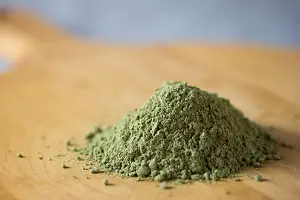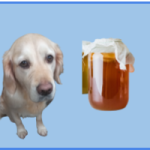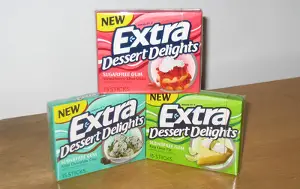
Matcha is a powder made from the leaf of a type of green tea.
Powdered tea leaves were first used in China over 1400 years ago!
Matcha is a very special sort of powdered tea because of the care and attention that is needed to grow the tea and then grind the leaves into powder.
The level of detail includes shading the tea bushes from the sun and not letting the stones that grind the leaves get too hot in case the powder is burnt which will change the flavour.
And matcha powder isn’t just used to make tea. It is used as a colouring as a flavouring in foods such as cakes, ice cream and even in Starbucks lattes.
But, is matcha safe for your dog to eat?
Can dogs have matcha powder?
The good news is that dogs can eat matcha powder.
Overall, the powder contains nothing that will poison your dog.
In some ways it might also be considered a super powder in the way that some foods are viewed as super foods.
Matcha powder contains extremely high levels of antioxidants and high levels of amino acids compared to other forms of green tea.
And I will go on to explain why antioxidants and amino acids might be so important to the health of our dogs.
But, matcha powder isn’t all good news as far as our dogs are concerned.
As it is derived from tea leaves, it contains very small quantities of caffeine- which in large doses is toxic to dogs.
Just because dogs can have matcha powder doesn’t mean that they should eat anything that has matcha powder in it- such as cakes and ice cream which were mentioned earlier.
What is the nutrition of matcha?
The two super nutrients in matcha powder are antioxidants and amino acids.
Does matcha contain lots of antioxidants?
Most of us by now have heard lots about antioxidants and know that they are very good for us (and our dogs) but are only vaguely aware of why that is.
Antioxidants help a dog’s body to fight free radicals.
Now free radicals aren’t some funky and weird political organisation with members who wander the streets carrying guns and chanting loudly.
They are harmful compounds that float around inside a dog’s body and could potentially cause some serious harm in the form of heart disease or cancer.
Matcha powder isn’t alone in containing high levels of antioxidants, other varieties of green tea also do.
But, a quick comparison will highlight just what a large gap there is between matcha powder and the rest of the field.
| Matcha | Green tea | |
| Antioxidants (per oz.) | 80 mg | 24 mg |
Ounce for ounce, matcha contains up to 3 times as much antioxidant as “run of the mill” green tea.
In every ounce of matcha there is about 80 mg of antioxidant compared to just 24 mg in normal green tea.
Does matcha contain lots of amino acids?
Amino acids are compounds which are so important to a dog’s body that they are known as building blocks- there are just so many fundamental processes which they are involved with.
These include functions as diverse as supporting digestion, providing energy and producing hormones.
Now, let’s not kid ourselves.
Matcha powder doesn’t contain anything like the variety or quantity of amino acids that your dog needs to survive and thrive.
But matcha powder does contain one important amino acid in quite high quantities.
And that amino acid is L- Theanine.
Which might help your dog in one very specific way.
L- threonine is known to reduce stress and anxiety in humans.
But it seems there is an epidemic of anxiety in our dogs.
One Finnish study of nearly 14,000 dogs found that around 70% exhibited problem behaviours such as excessive barking and destructiveness.
That is worth repeating- 72.5% of the dogs were stressed out.
But how does the level of l- threonine in matcha compare to the levels found in other green teas?
Matcha could contain up to nine times as much l- threonine.
Having found out what the hidden powers of matcha powder is when compared to bog standard green tea, I now want to compare it with other foods that are high in antioxidants.
Matcha vs other antioxidant foods?
As I mentioned earlier, antioxidants play a crucial role in our dog’s ability to fight some pretty scary conditions such as heart disease and cancer.
Obviously, matcha powder isn’t the only food or food product that contains high levels of them.
Other foods that are high in antioxidants include; dark chocolate, pecans, blueberries, goji berries, acai berries and strawberries.
Now before you go running off to the grocery store to buy some of these items, I need to make two points.
Firstly dark chocolate might contain high levels of antioxidants but don’t buy it to feed your dog because dark chocolate is highly toxic to dogs.
Secondly, none of these foods come anywhere close to containing the levels of antioxidants that matcha powder does.
It contains up to 7 times as many antioxidants as goji berries and fifteen times as many antioxidants as are present in blueberries.
How should I prepare matcha for my dog?
The standard guidelines for making a cup of matcha for a person seems to be by mixing 2g of matcha powder with 70 g (which is 70 ml) of hot water.
Hot water makes the powder easier to mix.
And because you will be feeding it to your dog, you should wait for it to cool.
And then add it to their main meal as a gravy.
Which leads us very nicely onto our next question…
How much matcha powder should I feed to my dog?
Following on from the last section, the simple answer to this is that you should feed your dog very little matcha because it is very potent, very expensive and it only contains one amino acid (L threonine) of the ten that dogs need in their diet.
It is worth remembering that most of us have our dogs on complete diets either by the canned food that they eat or their kibble.
Complete dog foods have all ten of these amino acids added in exactly the right quantities that your dog needs.
Next I want to look at how easy it is to buy matcha and for how much?
Is matcha powder widely available?
The good news is that matcha powder is widely available although it is quite expensive- depending on which way that you look at it. .
A best selling powder on Walmart will currently cost about $21 for sixteen ounces.
Now, going by the earlier recommendation (of using 2g of powder by cup) that is the equivalent of over two hundred cups of matcha, each one costing 10 cents each.
Thinking about other foods that are high in antioxidants, a 48 ounce bag of blueberries will cost you about $8 at Walmart.
Which makes blueberries about a tenth of the price of matcha powder.
But, if matcha powder contains 15 times the concentration of antioxidants that are in blueberries, the powder still equals better value.
To finish this article about dogs and matcha, I want to quickly mention a few popular food products where matcha is used as an ingredient.
None of the following products are healthy choices so from that standpoint alone, your dog shouldn’t be eating them.
Should dogs eat matcha ice cream?
Ice cream in any form is packed full of sugar and fat.
Too much of it will have the same effect on your dog as it will on you – a growing waistline.
Added to that is the problem that most dogs will have in digesting milk products.
As puppies, dogs can digest their mother’s milk but as they grow older they lose their ability to do this.
A final warning with regard to ice cream and dogs is that some ice creams are sugar free and many of these use the chemical xylitol which is highly toxic to dogs.
Should dogs eat matcha cake?
Most cakes aren’t toxic to dogs- specific ingredients that you might put in one, are. The main ones include chocolate and raisins.
I won’t repeat myself over the dangers of sugars.
Flour and eggs aren’t toxic to dogs.
Should dogs eat matcha latte?
Dogs shouldn’t drink coffee in any form, even if it is diluted with milk and matcha.
Caffeine is toxic to dogs.





